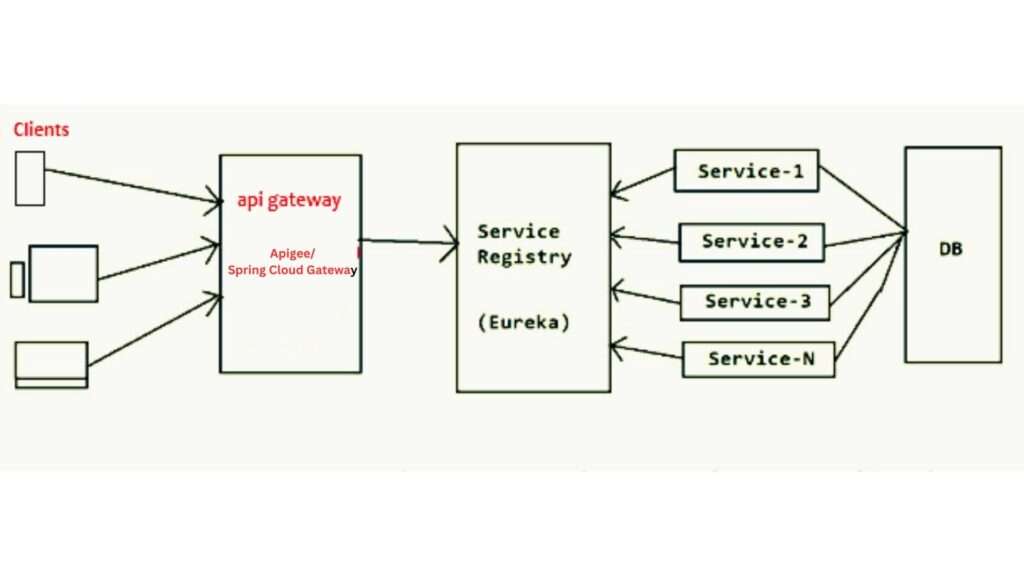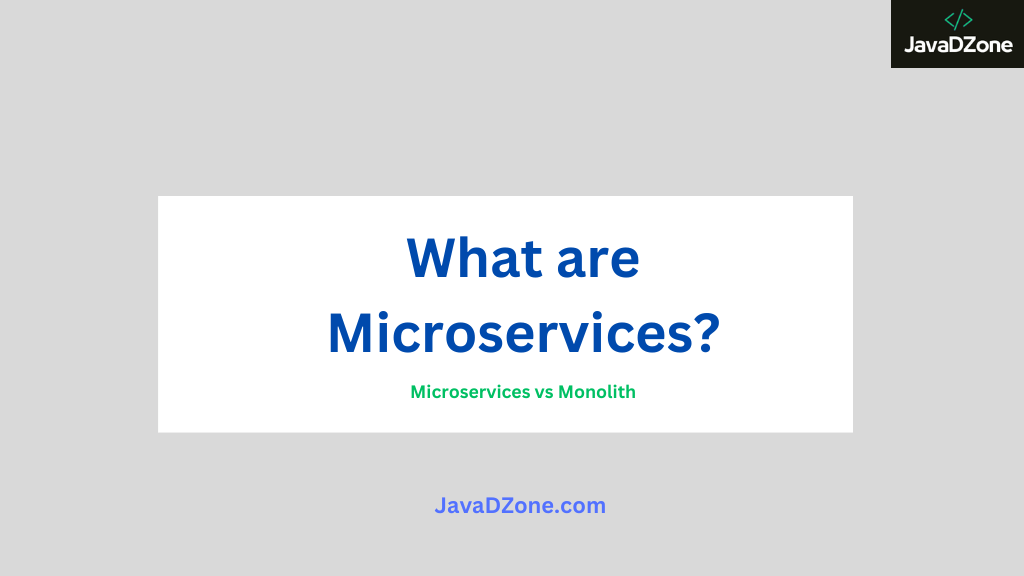Spring Boot Microservices, an innovative approach to developing software applications, involve decomposing the software application into
- Smaller
- Independent
- Deployable
- Loosely coupled
- Collaborative Services
Services through which we can bring down the complexity in understanding the application and ease the delivery of the application.
Before Moving to Microservices We need to understand Monolithic Architecture.
Table of Contents
Microservices vs Monolith
What is Monolithic Application Architecture?
Monolithic application has several modules as part of it, all of these modules are built as one single system and delivered as a single deployable artifact, which is nothing but monolithic application development architecture.
Microservices Architecture:

What are the reasons for choosing monolithic architecture
1. Easy to scale the applications.
2. You won’t to adopt continuous integration and delivery for your application
3. Developers will be able to quickly understand the application and be productive in development and delivery
Advantages of Monolithic Architecture
1. Achieving scalability is very easy :
if the load on the system is high, then we can copy the single deployable artifact of our application across multiple servers across the cluster.
2. Easy to understand
The entire software system has been built out of one single code base, the entire team of developers knows everything about the system they are working on. understanding such a software system out of a single code base is very easily and developers can be productive in building and delivery the application
3. As the entire system is build as a single deployable artifact we can easily achieve continuous integration and delivery(CI/CD) without any module dependency complexities
4. Monolithic architecture-based application development is better suited for applications that are less/moderate in size but if the application grows bigger in size, managing the development and delivery aspects of the system through monolithic architecture brings lot of problems.
Disadvantage of Monolithic Architecture
1. The entire system is built out of single codebase:
Many of the developers will be afraid to understand such a big system and feel very complicated in understanding and developing it.
Many of the developers don’t know how to achieve modularity in writing the code due to which they quickly exploit the code base.
A change impact is going to be very high and difficult to handle.
2. Overloaded (IDE)
Due to the huge code base, the ide’s cannot handle in managing the code.
To develop the code sophisticatedly by the developer he should ensure the code is loaded and in clean state in ide, he can write compilable code.
3. overloaded web containers
Deploying a huge application, makes the container take more time in starting up, and during debugging the application repeated deployment of the application for verifying code changes takes lot of time and kills the developer’s productivity.
4. Scalability
In monolithic architecture scalability is achieved in one dimension only which means horizontal scaling. If the application receives more volumes of request, even though the traffic comes to one or few modules of the system, we can only scale the system as a whole by deploying on multiple servers due to which
i). The cost of achieving the scalability is going to be very high, as the whole system is scaled up we need to buy big servers with huge computing capacity
ii). different parts of the system as different computing requirements, like few modules are memory intensive, few modules are CPU intensive, during scaleup we cannot consider such requirements in scaling up the system
5. Scaling up the Team is difficult
The more/bigger the application grows, we need more resources in the team to work on, but handling such a huge team is going to be pain point, as people cannot independently work on separate functional modules due to dependencies. resource handling becomes much complex in distributing the work.
6. Long-Term commitment to technology stack
While building application with monolithic architecture, we need to be committed to an technical stack in building the application for a long-term. because adopting new technologies requires the entire system to be migrated as it exists as a single code base.
7. CI/CD is going to be very difficult
When and ever a module has been finished its development, we cannot release it independently as other modules code changes are also part of the same code base due to long term release planning and deployments are required.
Microservices Architecture:
Microservices using Spring Boot
Microservices is an architectural style of developing software applications. In microservices based architecture we decompose the software application into
- Smaller
- Independent
- Deployable
- Loosely coupled
- Collaborative Services
We develop the application by breaking down the entire application in independent smaller services that can be developed and delivered by individual team of developers
We identify the business responsibilities and break them into independent services/projects which are built on REST architectural principles by independent teams and are deployable separately
Benefits of developing application on microservices architecture
1. They can be different team of developers can independently develop, test and delivery the system
2. Each service we develop has a separate source code which can be understood easily by the developer and can maintain it
- – achieving modularity becomes easy
- – change impact will be very minimal
- – debugging the code becomes very easy
3. Every team has their independent separate source code, they can get the code up quickly in an ide and can proceed for development
4. The more the services/functionality we can broke down into multiple independent services can choose more teams to develop parallelly
5. scalability
In microservices based application as each services/module is being deployed separately we can achieve vertical scaling
- depends on the traffic patterns we can scale a specific module or service quickly rather than the entire system where the cost of scalability is very less as we are scaling a piece of the system
- we can customize the machine capacity based on the nature of the service like cpu oriented/memory-oriented services
6. Adopting the new technologies can be really faster, either we can choose one of the services to be migrated out of the current system or we can build new services on the latest technology easily
7. Easy to achieve ci/cd as every service is independent of the others, we can deliver a service without bothering about the others.
Advantages of using microservices architecture?
- 1. as the smaller codebase it is easy to manage within the ide.
- 2. application servers are not overloaded and the application quickly gets started and debugging the application will not takes more time because of smaller code base
- 3. scalability we can achieve vertical scalability in microservices
- – a specific module can be scaled up independent of the whole system based on the traffic/load
- – we can customize the computing aspects in scaling the service like cpu bounded and memory bounded
- 4. we can adopt new technologies quickly, as services are development independently, we can migrate a service or develop new services are latest technologies
- 5. easy to understand and develop the application as each service is built out of its independent code base developer often feel very easy in understanding the system. modularity can be achieved very easily. impact of a change request is minimal and easy to manage. less complex and easy to maintain. debugging the application is going to be very easy.
- 6. ci/cd can be adopted easily
- 7. we can have multiple teams developing the system parallelly
Conclusion:
In the realm of software development, Spring Boot Microservices have emerged as a game-changer, offering agility, scalability, and modularity. We’ve explored the fundamental concepts behind microservices-based architecture and how they can reduce the complexity of software applications while enhancing delivery.
However, it’s essential to remember that successfully implementing microservices goes beyond theoretical knowledge. To master this architectural style and unlock its full potential, you’ll need to dive into practical implementations and real-world examples.
For More Practical Information:
Fortunately, all the practical tutorials and hands-on guidance you need to embark on your microservices journey are right here on our blog. Explore our comprehensive tutorials, case studies, and examples to gain not only a theoretical understanding but also the practical skills to apply microservices effectively in your software projects.
So, roll up your sleeves, venture into the world of microservices, and discover the transformative power they can bring to your software development endeavors—available exclusively on our blog!
When it comes to implementing microservices architecture, it’s crucial to have a solid understanding of the key principles and best practices. For more in-depth insights and resources, I recommend visiting Microservices.io.
